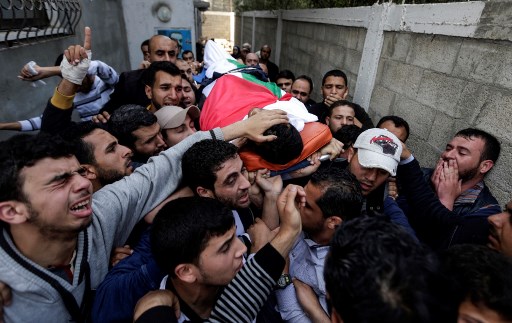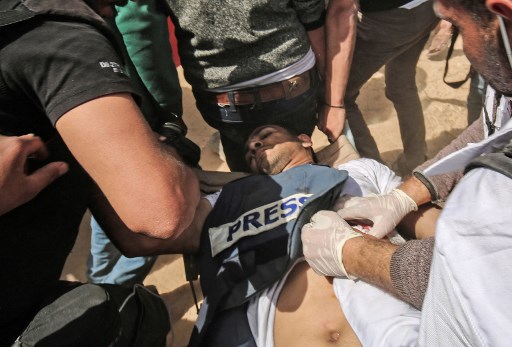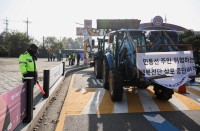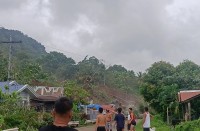
Among those killed at Friday’s protest was Yasser Murtaja, a photographer with the Gaza-based Ain Media agency, who died from his wounds after being shot, the local health ministry said.
Murtaja’s company confirmed his death, with witnesses saying he was close to the front of the protests in Southern Gaza when he was hit. / AFP PHOTO / MAHMUD HAMS
by Joe Dyke and Sakher Abou El Oun
Agence France Presse
GAZA City, Palestinian Territories (AFP) — Palestinian mourners in the Gaza Strip on Saturday were burying their dead, including a journalist, after Israeli troops killed nine during the latest border clashes in a week of bloodshed.
Thousands of protesters approached the border fence around Gaza for a second Friday in a row, burning tires and hurling stones at Israeli forces, who responded with tear gas and live ammunition.
In addition to the nine dead, at least 491 were wounded by Israeli gunfire, the health ministry in the Hamas-run Gaza enclave said.
Israel said there were around 20,000 protesters and that they were seeking to breach the border.
Numbers were down from the previous Friday, when tens of thousands approached the border in demonstrations that saw Israeli forces kill 19 Palestinians, making it the bloodiest day in Gaza since a 2014 war.
No Israelis were injured on either day and the latest deaths have sparked fresh calls for an investigation.
Among those killed on Friday was Yasser Murtaja, 30, a photographer with the Gaza-based Ain Media agency, who died from his wounds after being shot, the health ministry said.
Murtaja’s company confirmed his death, with witnesses saying he was close to the front of the protests in southern Gaza when he was hit.

Among those killed at Friday’s protest was Yasser Murtaja, a photographer with the Gaza-based Ain Media agency, who died from his wounds after being shot, the local health ministry said.
Murtaja’s company confirmed his death, with witnesses saying he was close to the front of the protests in Southern Gaza when he was hit. / AFP PHOTO / SAID KHATIB
An AFP picture taken after he was wounded showed Murtaja wearing a press vest as he received treatment.
His brother Motazem, also a journalist, said he was next to him when he was shot. “The target was very clearly journalists,” he said.
Israel’s army declined to comment, saying it was reviewing the incident.
– ‘Journalist targeted’ –
Murtaja’s body was taken from the hospital to his home in Gaza City Saturday morning, with dozens of journalists following, many fighting back tears.
It was wrapped in a Palestinian flag, with a press flak jacket placed on his stomach.
Ismail Haniya, the head of Gaza’s Islamist rulers Hamas, attended the funeral, AFP journalists said.
Haniya said journalists were attacked by Israel while trying to show a “true picture of a blockaded, downtrodden people”.
In the West Bank political capital of Ramallah, around 50 Palestinian journalists held a vigil for Murtaja.
Press watchdog Reporters Without Borders (RSF) said in a tweet it was “saddened to learn” that Murtaja had died after being “shot while covering Gaza demonstrations”.
The Palestinian Journalists’ Syndicate said five other reporters were also shot and wounded by the Israeli army during Friday’s protests, although they wore clothes clearly identifying them as journalists.
The Gaza health ministry on Saturday said a 20-year-old man, Hamza Abdel Aal, was also shot and killed by Israeli forces in central Gaza.
Some of the nine men were buried late Friday, while the rest were to be buried on Saturday.
– ‘Fence was not crossed’ –
Weeks of border protests have been called to demand the return of Palestinians to land they were forced from or fled after the founding of Israel 70 years ago.
They come with tensions high as the US gears up to shift its embassy in Israel to Jerusalem after recognizing the disputed city as the capital of the Jewish state.
Protesters on Friday said economic woes were also fuelling frustration in Gaza, which has been under an Israeli blockade for a decade.
Egypt has mostly closed its border with the territory in past years, leaving the cramped area of two million people largely sealed off.
“We are living like sardines,” said father of seven Ahmad al-Naqaa.
“I am ready to die for our land and our dignity,” the 40-year-old said as he joined the protests.
UN chief Antonio Guterres urged it to “exercise extreme caution with the use of force” ahead of the latest clashes.
And on Friday, Kuwait called on the Security Council to investigate the deaths.
Israel has rebuffed international calls for a probe into last Friday’s killings.
The Israeli army said its troops opened fire “in accordance with the rules of engagement”.
The military said “attempts were made to infiltrate into Israel under the cover of a smokescreen” and that firebombs and explosive devices were thrown at the soldiers.
Late Friday Israeli army spokesman Brigadier General Ronen Manelis classified the operation along the border as a success.
“None of our troops were wounded, the fence was not crossed,” he said, noting that what happened last week had “deterred Hamas, which prevented the masses from approaching the fence”.
Israel accuses Hamas, with whom it has fought three wars since 2008, of using the protests as a cover to carry out violence.
Israel alleges that more than half of those killed on March 30 were members of militant groups, including Hamas’s armed wing.
Hamas claimed only five of the dead and said they were participating “in popular events side-by-side with their people.”
The borders were quiet Saturday morning.
© Agence France-Presse







